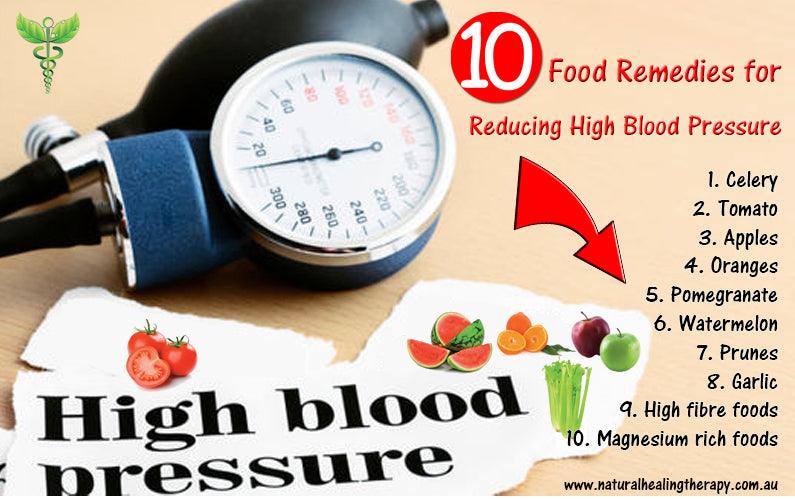High blood pressure is not a disease!
High blood pressure is the body’s natural healing therapy, initiated to cope with conditions such as toxins, impaired kidney function, glandular disturbances, being overweight and emotional disturbances like worry, fear and prolonged nervous stress.
If the underlying cause is one of emotional origin then it must be removed before any nutritional or biological solutions can be successful. When these are removed, the blood pressure will go down by itself.
Making lifestyle changes has proven to be very beneficial in reducing high blood pressure.
Here are ten food remedies I found in Don Tolman's Farmacist Desk Reference volume 2.
Ten Food Remedies for Reducing High Blood Pressure
1. Drink raw Celery juice three times a day.
Pthalides in Celery relax the muscles of the arteries that regulate blood pressure. This allows these vessels to dilate. Pthalides also reduce stress hormones, one of whose effects is to cause blood vessels to constrict. When researchers injected 3-n-butyl pthalide derived from celery, the blood pressure dropped 12 to 14 percent. To obtain an equivalent dose orally would be to eat about four stalks of celery.
2. Eat two Tomatoes on an empty stomach every day for a month. Tomatoes are rich in potassium, a mineral crucial for lowering blood pressure.
3. Eat three Apples daily or take a daily dose of apple cider vinegar in water to have soaring blood pressure under control in two weeks!
4. Juice your own Oranges. Arguably, the most important flavanone in oranges, herperidin has been shown to lower high blood pressure as well as cholesterol in animal studies, and to have strong anti-inflammatory properties. Importantly, most of this phytonutrient is found in the peel and inner white pulp of the orange,
5. Those with high blood pressure, who consume just two ounces of Pomegranate juice every day for two weeks, are able to lower their systolic blood pressure. Pomegranate juice significantly reduces ACE (angiotensin converting enzyme) activity, helping lower blood pressure, preventing heart disease and reducing the risk of stroke.
6. During the summer, make Watermelon juice or eat watermelon every day. This sweet, crunchy, cooling fruit is exceptionally high in citrulline, an amino acid our bodies use to make another amino acid, arginine, which is used in the urea cycle to remove ammonia from the body, and by the cells lining our blood vessels to make nitric oxide. Nitric oxide not only relaxes blood vessels but lowers high blood pressure.
7. A quarter cup of Prunes contains a whopping 316.6 mg of potassium.
Potassium is an important dietary electrolyte that helps maintain blood pressure levels. Studies indicate that people who consume optimal amounts of foods high in potassium generally have lower blood pressure than those whose potassium intake is low.
Wholefood Sources of Potassium: Beets, Bok Choy, Apricots (including dried), Pomegranates, organic Chocolate, Beans, Oranges, Water chestnuts, Tomatoes, Potatoes, Quinoa, Cantaloupe, Bananas, Figs, Avocados, Yogurt, Kiwifruit, Broccoli and Brussels sprouts.
8. Eat Garlic and garlic oil to clean out the arteries. Garlic helps by lowering fibrinogen levels, reducing the risk of heart attack and the danger of thrombosis caused by abnormal blood clotting.
9. A high fiber diet is recommended. A high fiber diet including seeded foods like brown rice, buckwheat, millet and oats are recommended along with plenty of raw fresh fruits and vegetables, such as apples, asparagus, bananas, broccoli, cabbage, raisins, squash and sweet potatoes. Eat small meals and do not overeat. Remember, obesity is one of the main causes of high blood pressure and heart disease.
10. Eating Foods high in Magnesium can help to lower blood pressure. Magnesium plays a part in reducing elevated blood pressure by relaxing the muscles that control blood vessels, allowing blood to flow more freely.
Sources of Magnesium: Spinach, Avocados, organic Chocolate, Pumpkin seeds, Sunflower seeds, Brazil nuts, Amaranth, Buckwheat, Almonds, Quinoa and Barley.
Avoid smoking, hard alcohol and all stimulants. Avoid foods that are high in animal fat and animal cholesterol. Foods such as aged meats and orange cheeses, anchovies, chicken liver, commercial chocolate, pickled herring, bacon, corned beef, pork sausage, smoked or processed meats, gravies and bouillons.
Food additives that should be avoided on a heart healthy diet include:
- Accent flavor-enhancer (monosodium glutamate MSG)
- baking powder (aluminum)
- canned vegetables
- commercially prepared foods
- over the counter medicines that contain ibuprofen
- diet soft drinks
- food with mold inhibitors and preservatives
- sugar substitutes
- and meat tenderizers
Exercise Therapy
Regular exercise also helps control blood sugars and body weight, improves blood flow, reduces high blood pressure, raises HDL cholesterol (“good” cholesterol) and strengthens the heart muscle.
Relaxation techniques like slow, deep breathing will bring your heart rate and respiration back to normal and reduce muscle tension and blood pressure.
article source: Farmacist Desk Reference Vol 2 by Don Tolman

